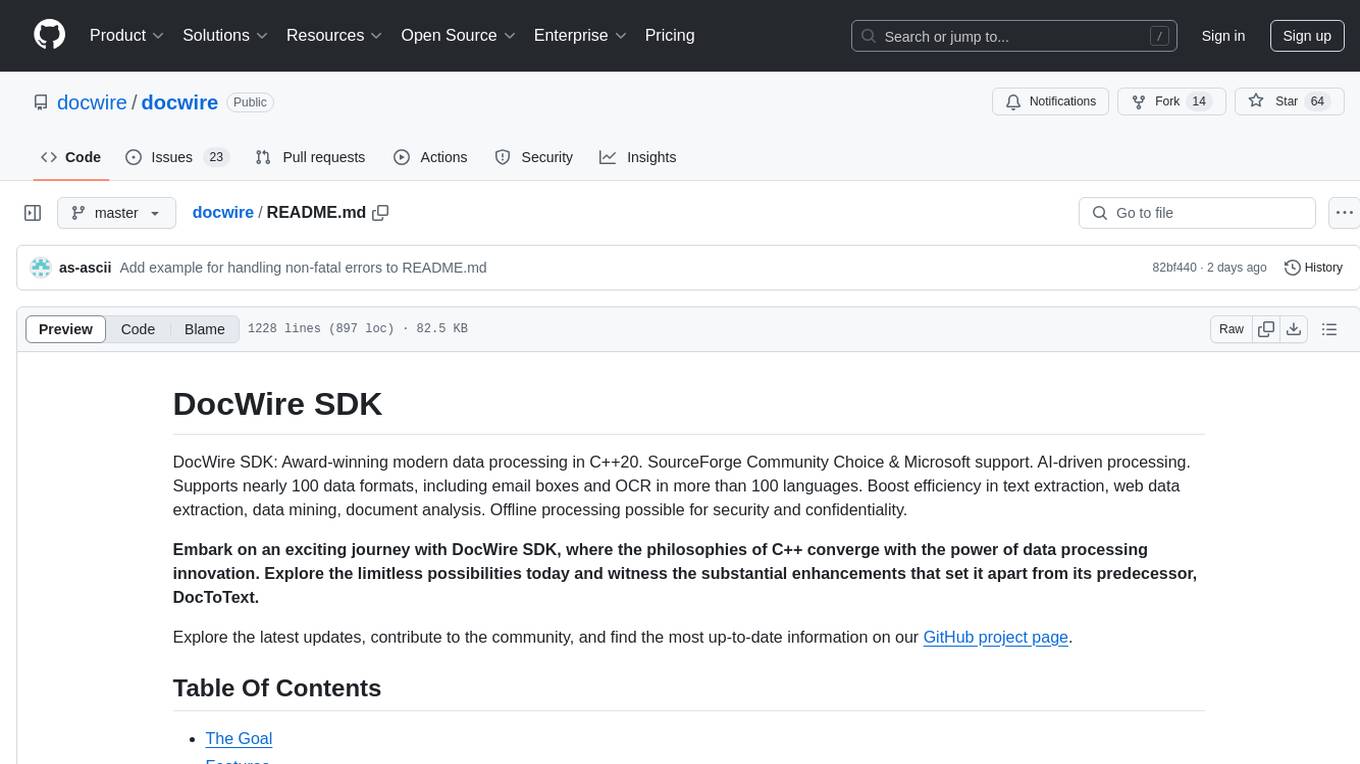
llm-course
Course to get into Large Language Models (LLMs) with roadmaps and Colab notebooks.
Stars: 42150
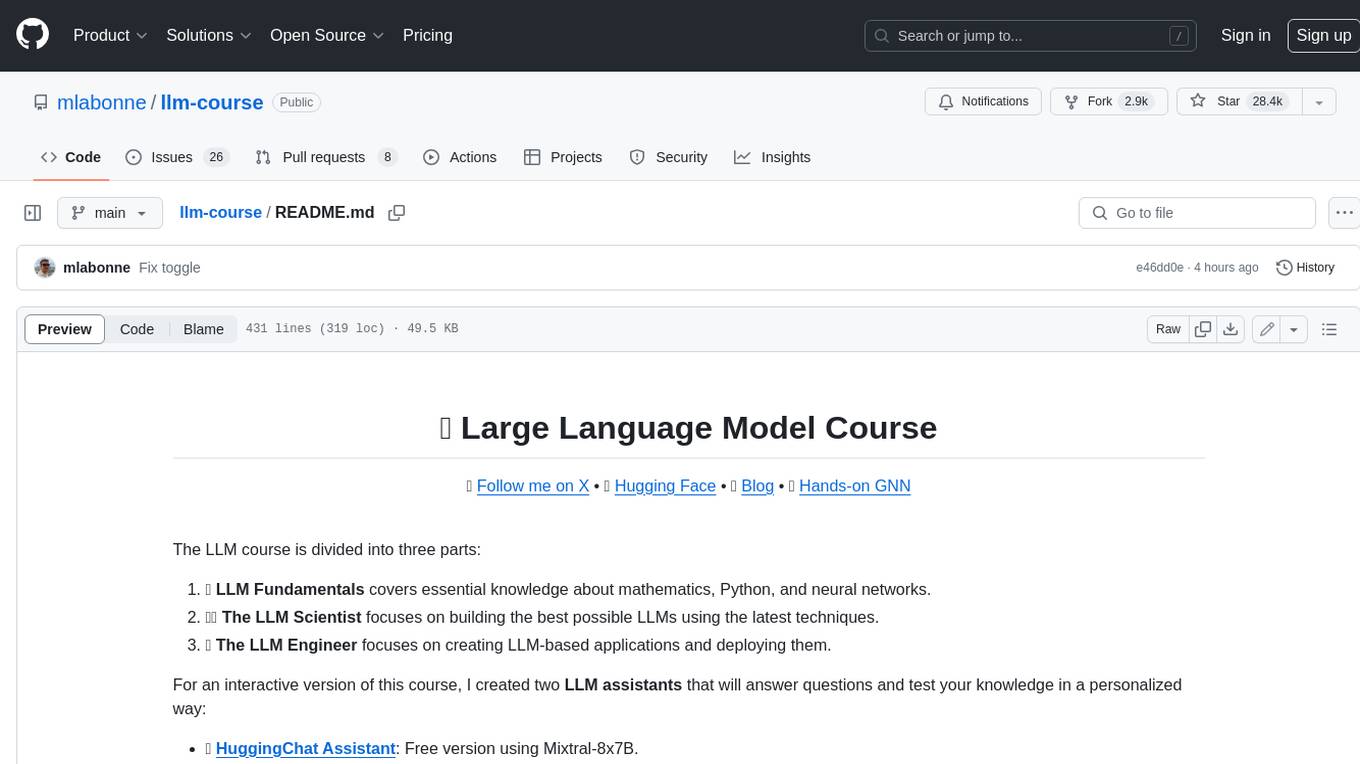
The LLM course is divided into three parts: 1. 🧩 **LLM Fundamentals** covers essential knowledge about mathematics, Python, and neural networks. 2. 🧑🔬 **The LLM Scientist** focuses on building the best possible LLMs using the latest techniques. 3. 👷 **The LLM Engineer** focuses on creating LLM-based applications and deploying them. For an interactive version of this course, I created two **LLM assistants** that will answer questions and test your knowledge in a personalized way: * 🤗 **HuggingChat Assistant**: Free version using Mixtral-8x7B. * 🤖 **ChatGPT Assistant**: Requires a premium account. ## 📝 Notebooks A list of notebooks and articles related to large language models. ### Tools | Notebook | Description | Notebook | |----------|-------------|----------| | 🧐 LLM AutoEval | Automatically evaluate your LLMs using RunPod |  | | 🥱 LazyMergekit | Easily merge models using MergeKit in one click. |  | | 🦎 LazyAxolotl | Fine-tune models in the cloud using Axolotl in one click. |  | | ⚡ AutoQuant | Quantize LLMs in GGUF, GPTQ, EXL2, AWQ, and HQQ formats in one click. |  | | 🌳 Model Family Tree | Visualize the family tree of merged models. |  | | 🚀 ZeroSpace | Automatically create a Gradio chat interface using a free ZeroGPU. |  |
README:

𝕏 Follow me on X • 🤗 Hugging Face • 💻 Blog • 📙 LLM Engineer's Handbook

- 🧩 LLM Fundamentals is optional and covers fundamental knowledge about mathematics, Python, and neural networks.
- 🧑🔬 The LLM Scientist focuses on building the best possible LLMs using the latest techniques.
- 👷 The LLM Engineer focuses on creating LLM-based applications and deploying them.
[!NOTE] Based on this course, I wrote the LLM Engineer's Handbook with Paul Iuzstin. It's a hands-on and detailed book that covers an end-to-end LLM application from design to deployment. The LLM course will always stay free but feel free to support my work by purchasing the book.
For an interactive version of this course, I created an LLM assistant that will answer questions and test your knowledge in a personalized way on HuggingChat or ChatGPT.
A list of notebooks and articles I wrote about LLMs.
| Notebook | Description | Notebook |
|---|---|---|
| 🧐 LLM AutoEval | Automatically evaluate your LLMs using RunPod | |
| 🥱 LazyMergekit | Easily merge models using MergeKit in one click. | |
| 🦎 LazyAxolotl | Fine-tune models in the cloud using Axolotl in one click. | |
| ⚡ AutoQuant | Quantize LLMs in GGUF, GPTQ, EXL2, AWQ, and HQQ formats in one click. | |
| 🌳 Model Family Tree | Visualize the family tree of merged models. | |
| 🚀 ZeroSpace | Automatically create a Gradio chat interface using a free ZeroGPU. |
| Notebook | Description | Article | Notebook |
|---|---|---|---|
| Fine-tune Llama 3.1 with Unsloth | Ultra-efficient supervised fine-tuning in Google Colab. | Article | |
| Fine-tune Llama 3 with ORPO | Cheaper and faster fine-tuning in a single stage with ORPO. | Article | |
| Fine-tune Mistral-7b with DPO | Boost the performance of supervised fine-tuned models with DPO. | Article | |
| Fine-tune Mistral-7b with QLoRA | Supervised fine-tune Mistral-7b in a free-tier Google Colab with TRL. | ||
| Fine-tune CodeLlama using Axolotl | End-to-end guide to the state-of-the-art tool for fine-tuning. | Article | |
| Fine-tune Llama 2 with QLoRA | Step-by-step guide to supervised fine-tune Llama 2 in Google Colab. | Article |
| Notebook | Description | Article | Notebook |
|---|---|---|---|
| Introduction to Quantization | Large language model optimization using 8-bit quantization. | Article | |
| 4-bit Quantization using GPTQ | Quantize your own open-source LLMs to run them on consumer hardware. | Article | |
| Quantization with GGUF and llama.cpp | Quantize Llama 2 models with llama.cpp and upload GGUF versions to the HF Hub. | Article | |
| ExLlamaV2: The Fastest Library to Run LLMs | Quantize and run EXL2 models and upload them to the HF Hub. | Article |
| Notebook | Description | Article | Notebook |
|---|---|---|---|
| Merge LLMs with MergeKit | Create your own models easily, no GPU required! | Article | |
| Create MoEs with MergeKit | Combine multiple experts into a single frankenMoE | Article | |
| Uncensor any LLM with abliteration | Fine-tuning without retraining | Article | |
| Improve ChatGPT with Knowledge Graphs | Augment ChatGPT's answers with knowledge graphs. | Article | |
| Decoding Strategies in Large Language Models | A guide to text generation from beam search to nucleus sampling | Article |
This section introduces essential knowledge about mathematics, Python, and neural networks. You might not want to start here but refer to it as needed.
Toggle section (optional)
Before mastering machine learning, it is important to understand the fundamental mathematical concepts that power these algorithms.
- Linear Algebra: This is crucial for understanding many algorithms, especially those used in deep learning. Key concepts include vectors, matrices, determinants, eigenvalues and eigenvectors, vector spaces, and linear transformations.
- Calculus: Many machine learning algorithms involve the optimization of continuous functions, which requires an understanding of derivatives, integrals, limits, and series. Multivariable calculus and the concept of gradients are also important.
- Probability and Statistics: These are crucial for understanding how models learn from data and make predictions. Key concepts include probability theory, random variables, probability distributions, expectations, variance, covariance, correlation, hypothesis testing, confidence intervals, maximum likelihood estimation, and Bayesian inference.
📚 Resources:
- 3Blue1Brown - The Essence of Linear Algebra: Series of videos that give a geometric intuition to these concepts.
- StatQuest with Josh Starmer - Statistics Fundamentals: Offers simple and clear explanations for many statistical concepts.
- AP Statistics Intuition by Ms Aerin: List of Medium articles that provide the intuition behind every probability distribution.
- Immersive Linear Algebra: Another visual interpretation of linear algebra.
- Khan Academy - Linear Algebra: Great for beginners as it explains the concepts in a very intuitive way.
- Khan Academy - Calculus: An interactive course that covers all the basics of calculus.
- Khan Academy - Probability and Statistics: Delivers the material in an easy-to-understand format.
Python is a powerful and flexible programming language that's particularly good for machine learning, thanks to its readability, consistency, and robust ecosystem of data science libraries.
- Python Basics: Python programming requires a good understanding of the basic syntax, data types, error handling, and object-oriented programming.
- Data Science Libraries: It includes familiarity with NumPy for numerical operations, Pandas for data manipulation and analysis, Matplotlib and Seaborn for data visualization.
- Data Preprocessing: This involves feature scaling and normalization, handling missing data, outlier detection, categorical data encoding, and splitting data into training, validation, and test sets.
- Machine Learning Libraries: Proficiency with Scikit-learn, a library providing a wide selection of supervised and unsupervised learning algorithms, is vital. Understanding how to implement algorithms like linear regression, logistic regression, decision trees, random forests, k-nearest neighbors (K-NN), and K-means clustering is important. Dimensionality reduction techniques like PCA and t-SNE are also helpful for visualizing high-dimensional data.
📚 Resources:
- Real Python: A comprehensive resource with articles and tutorials for both beginner and advanced Python concepts.
- freeCodeCamp - Learn Python: Long video that provides a full introduction into all of the core concepts in Python.
- Python Data Science Handbook: Free digital book that is a great resource for learning pandas, NumPy, Matplotlib, and Seaborn.
- freeCodeCamp - Machine Learning for Everybody: Practical introduction to different machine learning algorithms for beginners.
- Udacity - Intro to Machine Learning: Free course that covers PCA and several other machine learning concepts.
Neural networks are a fundamental part of many machine learning models, particularly in the realm of deep learning. To utilize them effectively, a comprehensive understanding of their design and mechanics is essential.
- Fundamentals: This includes understanding the structure of a neural network such as layers, weights, biases, and activation functions (sigmoid, tanh, ReLU, etc.)
- Training and Optimization: Familiarize yourself with backpropagation and different types of loss functions, like Mean Squared Error (MSE) and Cross-Entropy. Understand various optimization algorithms like Gradient Descent, Stochastic Gradient Descent, RMSprop, and Adam.
- Overfitting: Understand the concept of overfitting (where a model performs well on training data but poorly on unseen data) and learn various regularization techniques (dropout, L1/L2 regularization, early stopping, data augmentation) to prevent it.
- Implement a Multilayer Perceptron (MLP): Build an MLP, also known as a fully connected network, using PyTorch.
📚 Resources:
- 3Blue1Brown - But what is a Neural Network?: This video gives an intuitive explanation of neural networks and their inner workings.
- freeCodeCamp - Deep Learning Crash Course: This video efficiently introduces all the most important concepts in deep learning.
- Fast.ai - Practical Deep Learning: Free course designed for people with coding experience who want to learn about deep learning.
- Patrick Loeber - PyTorch Tutorials: Series of videos for complete beginners to learn about PyTorch.
NLP is a fascinating branch of artificial intelligence that bridges the gap between human language and machine understanding. From simple text processing to understanding linguistic nuances, NLP plays a crucial role in many applications like translation, sentiment analysis, chatbots, and much more.
- Text Preprocessing: Learn various text preprocessing steps like tokenization (splitting text into words or sentences), stemming (reducing words to their root form), lemmatization (similar to stemming but considers the context), stop word removal, etc.
- Feature Extraction Techniques: Become familiar with techniques to convert text data into a format that can be understood by machine learning algorithms. Key methods include Bag-of-words (BoW), Term Frequency-Inverse Document Frequency (TF-IDF), and n-grams.
- Word Embeddings: Word embeddings are a type of word representation that allows words with similar meanings to have similar representations. Key methods include Word2Vec, GloVe, and FastText.
- Recurrent Neural Networks (RNNs): Understand the working of RNNs, a type of neural network designed to work with sequence data. Explore LSTMs and GRUs, two RNN variants that are capable of learning long-term dependencies.
📚 Resources:
- Lena Voita - Word Embeddings: Beginner-friendly course about concepts related to word embeddings.
- RealPython - NLP with spaCy in Python: Exhaustive guide about the spaCy library for NLP tasks in Python.
- Kaggle - NLP Guide: A few notebooks and resources for a hands-on explanation of NLP in Python.
- Jay Alammar - The Illustration Word2Vec: A good reference to understand the famous Word2Vec architecture.
- Jake Tae - PyTorch RNN from Scratch: Practical and simple implementation of RNN, LSTM, and GRU models in PyTorch.
- colah's blog - Understanding LSTM Networks: A more theoretical article about the LSTM network.
This section of the course focuses on learning how to build the best possible LLMs using the latest techniques.
An in-depth knowledge of the Transformer architecture is not required, but it's important to understand the main steps of modern LLMs: converting text into numbers through tokenization, processing these tokens through layers including attention mechanisms, and finally generating new text through various sampling strategies.
- Architectural Overview: Understand the evolution from encoder-decoder Transformers to decoder-only architectures like GPT, which form the basis of modern LLMs. Focus on how these models process and generate text at a high level.
- Tokenization: Learn the principles of tokenization - how text is converted into numerical representations that LLMs can process. Explore different tokenization strategies and their impact on model performance and output quality.
- Attention mechanisms: Master the core concepts of attention mechanisms, particularly self-attention and its variants. Understand how these mechanisms enable LLMs to process long-range dependencies and maintain context throughout sequences.
- Sampling techniques: Explore various text generation approaches and their tradeoffs. Compare deterministic methods like greedy search and beam search with probabilistic approaches like temperature sampling and nucleus sampling.
📚 References:
- Visual intro to Transformers by 3Blue1Brown: Visual introduction to Transformers for complete beginners.
- LLM Visualization by Brendan Bycroft: Interactive 3D visualization of LLM internals.
- nanoGPT by Andrej Karpathy: A 2h-long YouTube video to reimplement GPT from scratch (for programmers). He also made a video about tokenization.
- Attention? Attention! by Lilian Weng: Historical overview to introduce the need for attention mechanisms.
- Decoding Strategies in LLMs by Maxime Labonne: Provide code and a visual introduction to the different decoding strategies to generate text.
Pre-training is a computationally intensive and expensive process. While it's not the focus of this course, it's important to have a solid understanding of how models are pre-trained, especially in terms of data and parameters. Pre-training can also be performed by hobbyists at a small scale with <1B models.
- Data preparation: Pre-training requires massive datasets (e.g., Llama 3.1 was trained on 15 trillion tokens) that need careful curation, cleaning, deduplication, and tokenization. Modern pre-training pipelines implement sophisticated filtering to remove low-quality or problematic content.
- Distributed training: Combine different parallelization strategies: data parallel (batch distribution), pipeline parallel (layer distribution), and tensor parallel (operation splitting). These strategies require optimized network communication and memory management across GPU clusters.
- Training optimization: Use adaptive learning rates with warm-up, gradient clipping and normalization to prevent explosions, mixed-precision training for memory efficiency, and modern optimizers (AdamW, Lion) with tuned hyperparameters.
- Monitoring: Track key metrics (loss, gradients, GPU stats) using dashboards, implement targeted logging for distributed training issues, and set up performance profiling to identify bottlenecks in computation and communication across devices.
📚 References:
- FineWeb by Penedo et al.: Article to recreate a large-scale dataset for LLM pretraining (15T), including FineWeb-Edu, a high-quality subset.
- RedPajama v2 by Weber et al.: Another article and paper about a large-scale pre-training dataset with a lot of interesting quality filters.
- nanotron by Hugging Face: Minimalistic LLM training codebase used to make SmolLM2.
- Parallel training by Chenyan Xiong: Overview of optimization and parallelism techniques.
- Distributed training by Duan et al.: A survey about efficient training of LLM on distributed architectures.
- OLMo 2 by AI2: Open-source language model with model, data, training, and evaluation code.
- LLM360 by LLM360: A framework for open-source LLMs with training and data preparation code, data, metrics, and models.
Post-training datasets have a precise structure with instructions and answers (supervised fine-tuning) or instructions and chosen/rejected answers (preference alignment). Conversational structures are a lot rarer than the raw text used for pre-training, which is why we often need to process seed data and refine it to improve the accuracy, diversity, and complexity of the samples. More information and examples are available in my repo 💾 LLM Datasets.
- Storage & chat templates: Because of the conversational structure, post-training datasets are stored in a specific format like ShareGPT or OpenAI/HF. Then, these formats are mapped to a chat template like ChatML or Alpaca to produce the final samples the model is trained on.
- Synthetic data generation: Create instruction-response pairs based on seed data using frontier models like GPT-4o. This approach allows for flexible and scalable dataset creation with high-quality answers. Key considerations include designing diverse seed tasks and effective system prompts.
- Data enhancement: Enhance existing samples using techniques like verified outputs (using unit tests or solvers), multiple answers with rejection sampling, Auto-Evol, Chain-of-Thought, Branch-Solve-Merge, personas, etc.
- Quality filtering: Traditional techniques involve rule-based filtering, removing duplicates or near-duplicates (with MinHash or embeddings), and n-gram decontamination. Reward models and judge LLMs complement this step with fine-grained and customizable quality control.
📚 References:
- Synthetic Data Generator by Argilla: Beginner-friendly way of building datasets using natural language in a Hugging Face space.
- LLM Datasets by Maxime Labonne: Curated list of datasets and tools for post-training.
- NeMo-Curator by Nvidia: Dataset preparation and curation framework for pre and post-training data.
- Distilabel by Argilla: Framework to generate synthetic data. It also includes interesting reproductions of papers like UltraFeedback.
- Semhash by MinishLab: Minimalistic library for near-deduplication and decontamination with a distilled embedding model.
- Chat Template by Hugging Face: Hugging Face's documentation about chat templates.
SFT turns base models into helpful assistants, capable of answering questions and following instructions. During this process, they learn how to structure answers and reactivate a subset of knowledge learned during pre-training. Instilling new knowledge is possible but superficial: it cannot be used to learn a completely new language. Always prioritize data quality over parameter optimization.
- Training techniques: Full fine-tuning updates all model parameters but requires significant compute. Parameter-efficient fine-tuning techniques like LoRA and QLoRA reduce memory requirements by training a small number of adapter parameters while keeping base weights frozen. QLoRA combines 4-bit quantization with LoRA to reduce VRAM usage.
- Training parameters: Key parameters include learning rate with schedulers, batch size, gradient accumulation, number of epochs, optimizer (like 8-bit AdamW), weight decay for regularization, and warmup steps for training stability. LoRA also adds three parameters: rank (typically 16-128), alpha (1-2x rank), and target modules.
- Distributed training: Scale training across multiple GPUs using DeepSpeed or FSDP. DeepSpeed provides three ZeRO optimization stages with increasing levels of memory efficiency through state partitioning. Both methods support gradient checkpointing for memory efficiency.
- Monitoring: Track training metrics including loss curves, learning rate schedules, and gradient norms. Monitor for common issues like loss spikes, gradient explosions, or performance degradation.
📚 References:
- Fine-tune Llama 3.1 Ultra-Efficiently with Unsloth by Maxime Labonne: Hands-on tutorial on how to fine-tune a Llama 3.1 model using Unsloth.
- Axolotl - Documentation by Wing Lian: Lots of interesting information related to distributed training and dataset formats.
- Mastering LLMs by Hamel Husain: Collection of educational resources about fine-tuning (but also RAG, evaluation, applications, and prompt engineering).
- LoRA insights by Sebastian Raschka: Practical insights about LoRA and how to select the best parameters.
Preference alignment is a second stage in the post-training pipeline, focused on aligning generated answers with human preferences. This stage was designed to tune the tone of LLMs and reduce toxicity and hallucinations. However, it has become increasingly important to also boost their performance and improve usefulness. Unlike SFT, there are many preference alignment algorithms. Here, we'll focus on the two most important ones: DPO and PPO.
- Rejection sampling: For each prompt, use the trained model to generate multiple responses, and score them to infer chosen/rejected answers. This creates on-policy data, where both responses come from the model being trained, improving alignment stability.
- Direct Preference Optimization Directly optimizes the policy to maximize the likelihood of chosen responses over rejected ones. It doesn't require reward modeling, which makes it more computationally efficient than PPO but slightly worse in terms of quality.
- Proximal Policy Optimization: Iteratively updates policy to maximize reward while staying close to initial behavior. It uses a reward model to score responses and requires careful tuning of hyperparameters including learning rate, batch size, and PPO clip range.
- Monitoring: In addition to SFT metrics, you want to maximize the margin between chosen and preferred answers. The accuracy should also gradually increase until it plateaus.
📚 References:
- Illustrating RLHF by Hugging Face: Introduction to RLHF with reward model training and fine-tuning with reinforcement learning.
- LLM Training: RLHF and Its Alternatives by Sebastian Rashcka: Overview of the RLHF process and alternatives like RLAIF.
- Preference Tuning LLMs by Hugging Face: Comparison of the DPO, IPO, and KTO algorithms to perform preference alignment.
- Fine-tune Mistral-7b with DPO by Maxime Labonne: Tutorial to fine-tune a Mistral-7b model with DPO and reproduce NeuralHermes-2.5.
- DPO Wandb logs by Alexander Vishnevskiy: It shows you the main metrics to track and the trends you should expect.
Reliably evaluating LLMs is a complex but essential task guiding data generation and training. It provides invaluable feedback about areas of improvement, which can be leveraged to modify the data mixture, quality, and training parameters. However, it's always good to remember Goodhart's law: "When a measure becomes a target, it ceases to be a good measure."
- Automated benchmarks: Evaluate models on specific tasks using curated datasets and metrics, like MMLU. It works well for concrete tasks but struggles with abstract and creative capabilities. It is also prone to data contamination.
- Human evaluation: It involves humans prompting models and grading responses. Methods range from vibe checks to systematic annotations with specific guidelines and large-scale community voting (arena). It is more suited for subjective tasks and less reliable for factual accuracy.
- Model-based evaluation: Use judge and reward models to evaluate model outputs. It highly correlates with human preferences but suffers from bias toward their own outputs and inconsistent scoring.
- Feedback signal: Analyze error patterns to identify specific weaknesses, such as limitations in following complex instructions, lack of specific knowledge, or susceptibility to adversarial prompts. This can be improved with better data generation and training parameters.
📚 References:
- Evaluation guidebook by Clémentine Fourrier: Practical insights and theoretical knowledge about LLM evaluation.
- Open LLM Leaderboard by Hugging Face: Main leaderboard to compare LLMs in an open and reproducible way (automated benchmarks).
- Language Model Evaluation Harness by EleutherAI: A popular framework for evaluating LLMs using automated benchmarks.
- Lighteval by Hugging Face: Alternative evaluation framework that also includes model-based evaluations.
- Chatbot Arena by LMSYS: Elo rating of general-purpose LLMs, based on comparisons made by humans (human evaluation).
Quantization is the process of converting the parameters and activations of a model using a lower precision. For example, weights stored using 16 bits can be converted into a 4-bit representation. This technique has become increasingly important to reduce the computational and memory costs associated with LLMs.
- Base techniques: Learn the different levels of precision (FP32, FP16, INT8, etc.) and how to perform naïve quantization with absmax and zero-point techniques.
- GGUF & llama.cpp: Originally designed to run on CPUs, llama.cpp and the GGUF format have become the most popular tools to run LLMs on consumer-grade hardware. It supports storing special tokens, vocabulary, and metadata in a single file.
- GPTQ & AWQ: Techniques like GPTQ/EXL2 and AWQ introduce layer-by-layer calibration that retains performance at extremely low bitwidths. They reduce catastrophic outliers using dynamic scaling, selectively skipping or re-centering the heaviest parameters.
- SmoothQuant & ZeroQuant: New quantization-friendly transformations (SmoothQuant) and compiler-based optimizations (ZeroQuant) help mitigate outliers before quantization. They also reduce hardware overhead by fusing certain ops and optimizing dataflow.
📚 References:
- Introduction to quantization by Maxime Labonne: Overview of quantization, absmax and zero-point quantization, and LLM.int8() with code.
- Quantize Llama models with llama.cpp by Maxime Labonne: Tutorial on how to quantize a Llama 2 model using llama.cpp and the GGUF format.
- 4-bit LLM Quantization with GPTQ by Maxime Labonne: Tutorial on how to quantize an LLM using the GPTQ algorithm with AutoGPTQ.
- Understanding Activation-Aware Weight Quantization by FriendliAI: Overview of the AWQ technique and its benefits.
- SmoothQuant on Llama 2 7B by MIT HAN Lab: Tutorial on how to use SmoothQuant with a Llama 2 model in 8-bit precision.
- DeepSpeed Model Compression by DeepSpeed: Tutorial on how to use ZeroQuant and extreme compression (XTC) with DeepSpeed Compression.
Here are notable topics that didn't fit into other categories. Some are established (model merging, multimodal) techniques, but others are more experimental (interpretability, test-time compute scaling) and the focus of numerous research papers.
- Model merging: Merging trained models has become a popular way of creating performant models without any fine-tuning. The popular mergekit library implements the most popular merging methods, like SLERP, DARE, and TIES.
- Multimodal models: These models (like CLIP, Stable Diffusion, or LLaVA) process multiple types of inputs (text, images, audio, etc.) with a unified embedding space, which unlocks powerful applications like text-to-image.
- Interpretability: Mechanistic interpretability techniques like Sparse Autoencoders (SAEs) made remarkable progress to provide insights about the inner workings of LLMs. This has also been applied with techniques such as abliteration, which allow you to modify the behavior of models without training.
- Test-time compute: Scaling the compute budget during test time requires numerous calls and involves specialized models like a Process Reward Model (PRM). Iterative steps with precise scoring significantly improve performance for complex reasoning tasks.
📚 References:
- Merge LLMs with mergekit by Maxime Labonne: Tutorial about model merging using mergekit.
- Smol Vision by Merve Noyan: Collection of notebooks and scripts dedicated to small multimodal models.
- Large Multimodal Models by Chip Huyen: Overview of multimodal systems and the recent history of this field.
- Unsensor any LLM with abliteration by Maxime Labonne: Direct application of interpretability techniques to modify the style of a model.
- Intuitive Explanation of SAEs by Adam Karvonen: Article about how SAEs work and why they make sense for interpretability.
- Scaling test-time compute by Beeching et al.: Tutorial and experiments to outperform Llama 3.1 70B on MATH-500 with a 3B model.
This section of the course focuses on learning how to build LLM-powered applications that can be used in production, with a focus on augmenting models and deploying them.
Running LLMs can be difficult due to high hardware requirements. Depending on your use case, you might want to simply consume a model through an API (like GPT-4) or run it locally. In any case, additional prompting and guidance techniques can improve and constrain the output for your applications.
- LLM APIs: APIs are a convenient way to deploy LLMs. This space is divided between private LLMs (OpenAI, Google, Anthropic, Cohere, etc.) and open-source LLMs (OpenRouter, Hugging Face, Together AI, etc.).
- Open-source LLMs: The Hugging Face Hub is a great place to find LLMs. You can directly run some of them in Hugging Face Spaces, or download and run them locally in apps like LM Studio or through the CLI with llama.cpp or Ollama.
- Prompt engineering: Common techniques include zero-shot prompting, few-shot prompting, chain of thought, and ReAct. They work better with bigger models, but can be adapted to smaller ones.
- Structuring outputs: Many tasks require a structured output, like a strict template or a JSON format. Libraries like LMQL, Outlines, Guidance, etc. can be used to guide the generation and respect a given structure.
📚 References:
- Run an LLM locally with LM Studio by Nisha Arya: Short guide on how to use LM Studio.
- Prompt engineering guide by DAIR.AI: Exhaustive list of prompt techniques with examples
- Outlines - Quickstart: List of guided generation techniques enabled by Outlines.
- LMQL - Overview: Introduction to the LMQL language.
Creating a vector storage is the first step to building a Retrieval Augmented Generation (RAG) pipeline. Documents are loaded, split, and relevant chunks are used to produce vector representations (embeddings) that are stored for future use during inference.
- Ingesting documents: Document loaders are convenient wrappers that can handle many formats: PDF, JSON, HTML, Markdown, etc. They can also directly retrieve data from some databases and APIs (GitHub, Reddit, Google Drive, etc.).
- Splitting documents: Text splitters break down documents into smaller, semantically meaningful chunks. Instead of splitting text after n characters, it's often better to split by header or recursively, with some additional metadata.
- Embedding models: Embedding models convert text into vector representations. It allows for a deeper and more nuanced understanding of language, which is essential to perform semantic search.
- Vector databases: Vector databases (like Chroma, Pinecone, Milvus, FAISS, Annoy, etc.) are designed to store embedding vectors. They enable efficient retrieval of data that is 'most similar' to a query based on vector similarity.
📚 References:
- LangChain - Text splitters: List of different text splitters implemented in LangChain.
- Sentence Transformers library: Popular library for embedding models.
- MTEB Leaderboard: Leaderboard for embedding models.
- The Top 5 Vector Databases by Moez Ali: A comparison of the best and most popular vector databases.
With RAG, LLMs retrieve contextual documents from a database to improve the accuracy of their answers. RAG is a popular way of augmenting the model's knowledge without any fine-tuning.
- Orchestrators: Orchestrators (like LangChain, LlamaIndex, FastRAG, etc.) are popular frameworks to connect your LLMs with tools, databases, memories, etc. and augment their abilities.
- Retrievers: User instructions are not optimized for retrieval. Different techniques (e.g., multi-query retriever, HyDE, etc.) can be applied to rephrase/expand them and improve performance.
- Memory: To remember previous instructions and answers, LLMs and chatbots like ChatGPT add this history to their context window. This buffer can be improved with summarization (e.g., using a smaller LLM), a vector store + RAG, etc.
- Evaluation: We need to evaluate both the document retrieval (context precision and recall) and generation stages (faithfulness and answer relevancy). It can be simplified with tools Ragas and DeepEval.
📚 References:
- Llamaindex - High-level concepts: Main concepts to know when building RAG pipelines.
- Pinecone - Retrieval Augmentation: Overview of the retrieval augmentation process.
- LangChain - Q&A with RAG: Step-by-step tutorial to build a typical RAG pipeline.
- LangChain - Memory types: List of different types of memories with relevant usage.
- RAG pipeline - Metrics: Overview of the main metrics used to evaluate RAG pipelines.
Real-life applications can require complex pipelines, including SQL or graph databases, as well as automatically selecting relevant tools and APIs. These advanced techniques can improve a baseline solution and provide additional features.
- Query construction: Structured data stored in traditional databases requires a specific query language like SQL, Cypher, metadata, etc. We can directly translate the user instruction into a query to access the data with query construction.
- Agents and tools: Agents augment LLMs by automatically selecting the most relevant tools to provide an answer. These tools can be as simple as using Google or Wikipedia, or more complex like a Python interpreter or Jira.
- Post-processing: Final step that processes the inputs that are fed to the LLM. It enhances the relevance and diversity of documents retrieved with re-ranking, RAG-fusion, and classification.
- Program LLMs: Frameworks like DSPy allow you to optimize prompts and weights based on automated evaluations in a programmatic way.
📚 References:
- LangChain - Query Construction: Blog post about different types of query construction.
- LangChain - SQL: Tutorial on how to interact with SQL databases with LLMs, involving Text-to-SQL and an optional SQL agent.
- Pinecone - LLM agents: Introduction to agents and tools with different types.
- LLM Powered Autonomous Agents by Lilian Weng: A more theoretical article about LLM agents.
- LangChain - OpenAI's RAG: Overview of the RAG strategies employed by OpenAI, including post-processing.
- DSPy in 8 Steps: General-purpose guide to DSPy introducing modules, signatures, and optimizers.
Text generation is a costly process that requires expensive hardware. In addition to quantization, various techniques have been proposed to maximize throughput and reduce inference costs.
- Flash Attention: Optimization of the attention mechanism to transform its complexity from quadratic to linear, speeding up both training and inference.
- Key-value cache: Understand the key-value cache and the improvements introduced in Multi-Query Attention (MQA) and Grouped-Query Attention (GQA).
- Speculative decoding: Use a small model to produce drafts that are then reviewed by a larger model to speed up text generation.
📚 References:
- GPU Inference by Hugging Face: Explain how to optimize inference on GPUs.
- LLM Inference by Databricks: Best practices for how to optimize LLM inference in production.
- Optimizing LLMs for Speed and Memory by Hugging Face: Explain three main techniques to optimize speed and memory, namely quantization, Flash Attention, and architectural innovations.
- Assisted Generation by Hugging Face: HF's version of speculative decoding, it's an interesting blog post about how it works with code to implement it.
Deploying LLMs at scale is an engineering feat that can require multiple clusters of GPUs. In other scenarios, demos and local apps can be achieved with a much lower complexity.
- Local deployment: Privacy is an important advantage that open-source LLMs have over private ones. Local LLM servers (LM Studio, Ollama, oobabooga, kobold.cpp, etc.) capitalize on this advantage to power local apps.
- Demo deployment: Frameworks like Gradio and Streamlit are helpful to prototype applications and share demos. You can also easily host them online, for example using Hugging Face Spaces.
- Server deployment: Deploy LLMs at scale requires cloud (see also SkyPilot) or on-prem infrastructure and often leverage optimized text generation frameworks like TGI, vLLM, etc.
- Edge deployment: In constrained environments, high-performance frameworks like MLC LLM and mnn-llm can deploy LLM in web browsers, Android, and iOS.
📚 References:
- Streamlit - Build a basic LLM app: Tutorial to make a basic ChatGPT-like app using Streamlit.
- HF LLM Inference Container: Deploy LLMs on Amazon SageMaker using Hugging Face's inference container.
- Philschmid blog by Philipp Schmid: Collection of high-quality articles about LLM deployment using Amazon SageMaker.
- Optimizing latence by Hamel Husain: Comparison of TGI, vLLM, CTranslate2, and mlc in terms of throughput and latency.
In addition to traditional security problems associated with software, LLMs have unique weaknesses due to the way they are trained and prompted.
- Prompt hacking: Different techniques related to prompt engineering, including prompt injection (additional instruction to hijack the model's answer), data/prompt leaking (retrieve its original data/prompt), and jailbreaking (craft prompts to bypass safety features).
- Backdoors: Attack vectors can target the training data itself, by poisoning the training data (e.g., with false information) or creating backdoors (secret triggers to change the model's behavior during inference).
- Defensive measures: The best way to protect your LLM applications is to test them against these vulnerabilities (e.g., using red teaming and checks like garak) and observe them in production (with a framework like langfuse).
📚 References:
- OWASP LLM Top 10 by HEGO Wiki: List of the 10 most critical vulnerabilities seen in LLM applications.
- Prompt Injection Primer by Joseph Thacker: Short guide dedicated to prompt injection for engineers.
- LLM Security by @llm_sec: Extensive list of resources related to LLM security.
- Red teaming LLMs by Microsoft: Guide on how to perform red teaming with LLMs.
This roadmap was inspired by the excellent DevOps Roadmap from Milan Milanović and Romano Roth.
Special thanks to:
- Thomas Thelen for motivating me to create a roadmap
- André Frade for his input and review of the first draft
- Dino Dunn for providing resources about LLM security
- Magdalena Kuhn for improving the "human evaluation" part
- Odoverdose for suggesting 3Blue1Brown's video about Transformers
- Everyone who contributed to the educational references in this course :)
Disclaimer: I am not affiliated with any sources listed here.
For Tasks:
Click tags to check more tools for each tasksFor Jobs:
Alternative AI tools for llm-course
Similar Open Source Tools

llm-course
The LLM course is divided into three parts: 1. 🧩 **LLM Fundamentals** covers essential knowledge about mathematics, Python, and neural networks. 2. 🧑🔬 **The LLM Scientist** focuses on building the best possible LLMs using the latest techniques. 3. 👷 **The LLM Engineer** focuses on creating LLM-based applications and deploying them. For an interactive version of this course, I created two **LLM assistants** that will answer questions and test your knowledge in a personalized way: * 🤗 **HuggingChat Assistant**: Free version using Mixtral-8x7B. * 🤖 **ChatGPT Assistant**: Requires a premium account. ## 📝 Notebooks A list of notebooks and articles related to large language models. ### Tools | Notebook | Description | Notebook | |----------|-------------|----------| | 🧐 LLM AutoEval | Automatically evaluate your LLMs using RunPod |  | | 🥱 LazyMergekit | Easily merge models using MergeKit in one click. |  | | 🦎 LazyAxolotl | Fine-tune models in the cloud using Axolotl in one click. |  | | ⚡ AutoQuant | Quantize LLMs in GGUF, GPTQ, EXL2, AWQ, and HQQ formats in one click. |  | | 🌳 Model Family Tree | Visualize the family tree of merged models. |  | | 🚀 ZeroSpace | Automatically create a Gradio chat interface using a free ZeroGPU. |  |
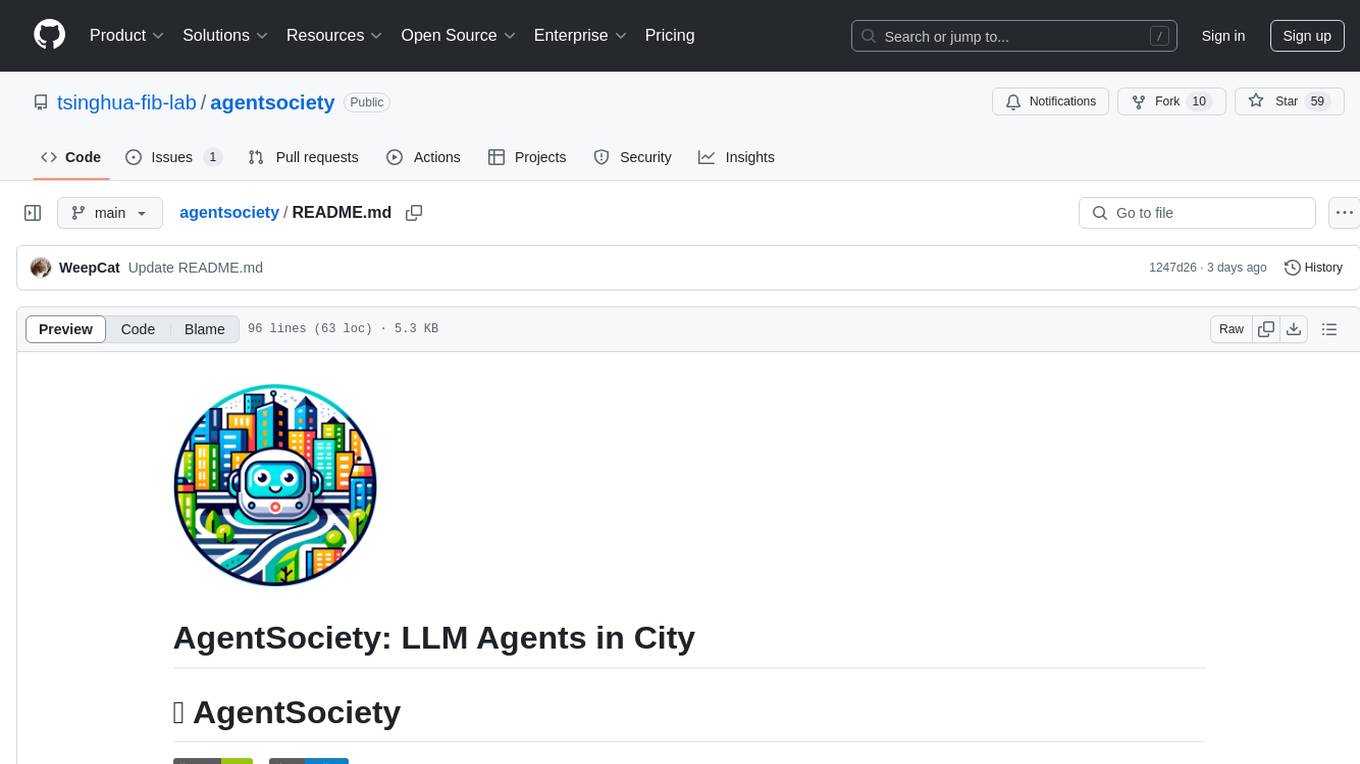
agentsociety
AgentSociety is an advanced framework designed for building agents in urban simulation environments. It integrates LLMs' planning, memory, and reasoning capabilities to generate realistic behaviors. The framework supports dataset-based, text-based, and rule-based environments with interactive visualization. It includes tools for interviews, surveys, interventions, and metric recording tailored for social experimentation.
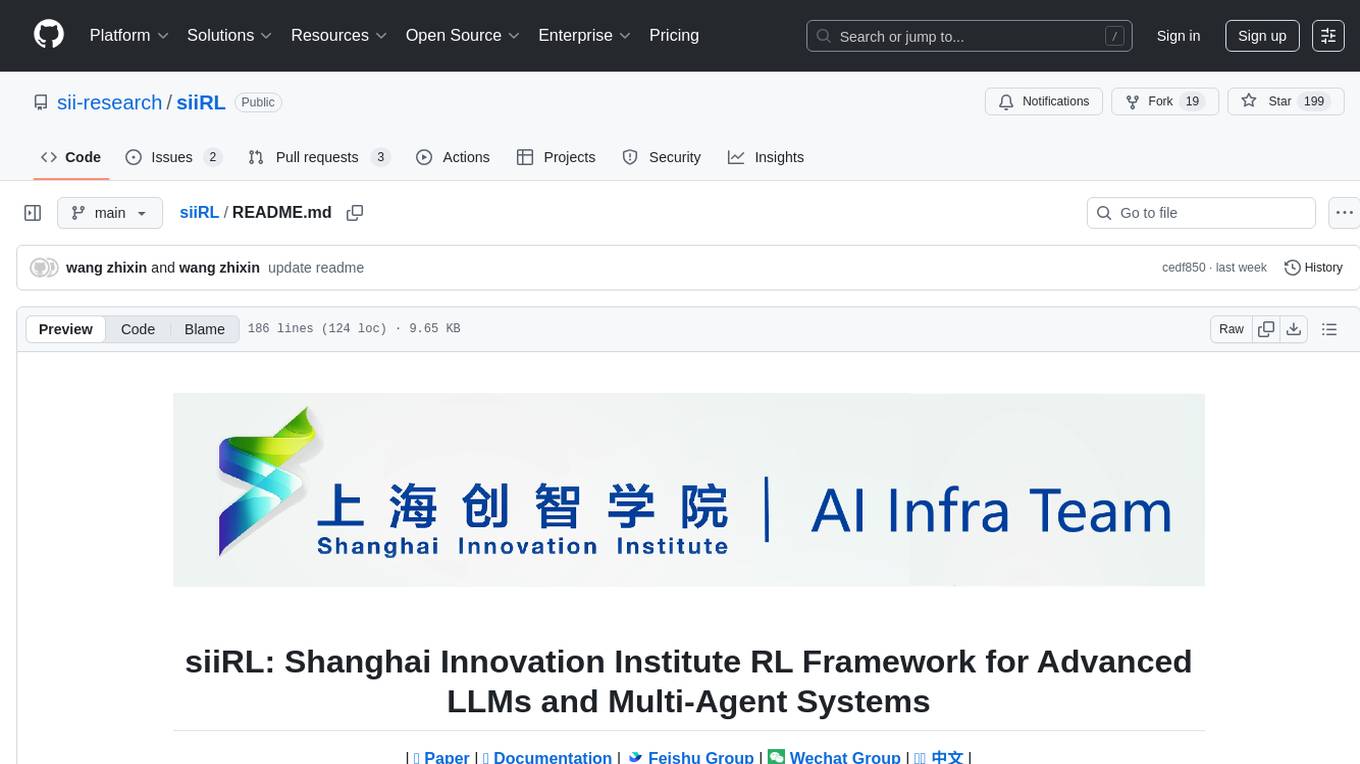
siiRL
siiRL is a novel, fully distributed reinforcement learning (RL) framework designed to break the scaling barriers in Large Language Models (LLMs) post-training. Developed by researchers from Shanghai Innovation Institute, siiRL delivers near-linear scalability, dramatic throughput gains, and unprecedented flexibility for RL-based LLM development. It eliminates the centralized controller common in other frameworks, enabling scalability to thousands of GPUs, achieving state-of-the-art throughput, and supporting cross-hardware compatibility. siiRL is extensively benchmarked and excels in data-intensive workloads such as long-context and multi-modal training.
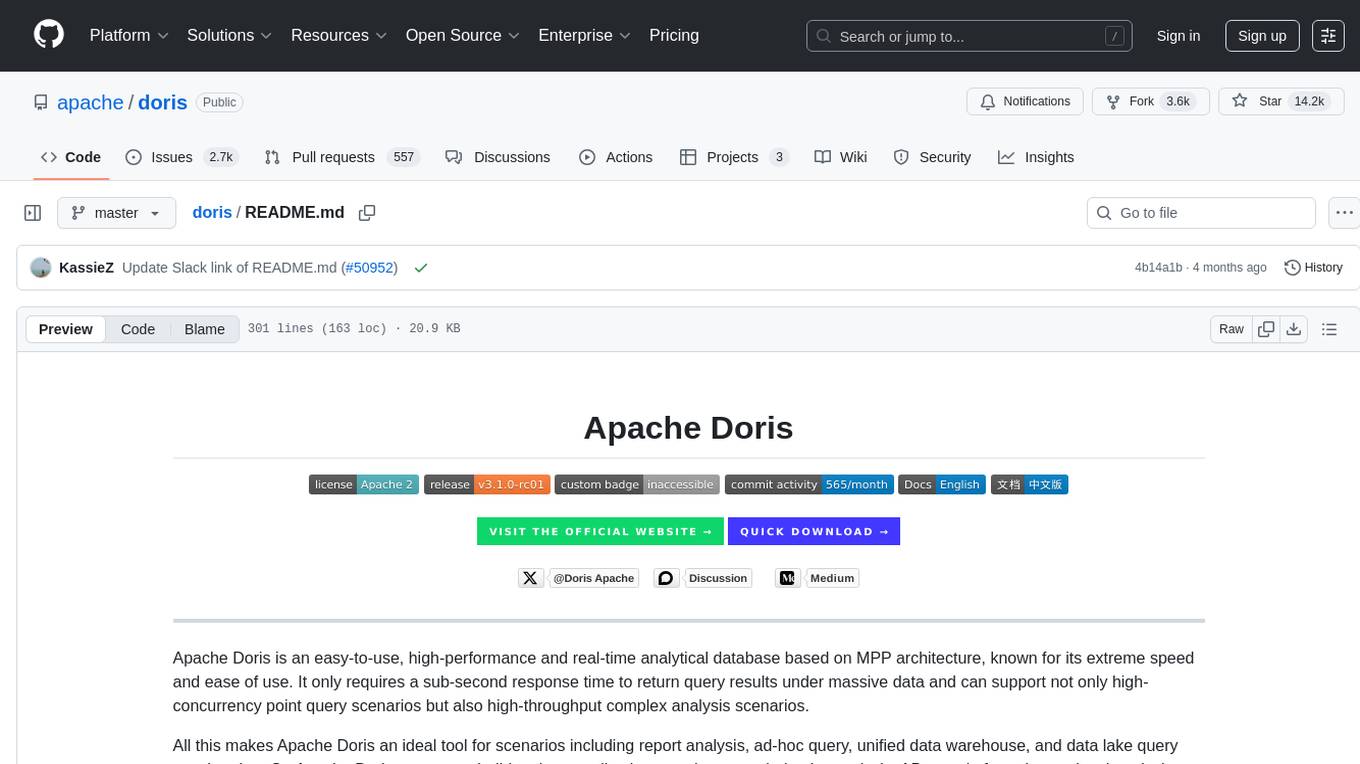
doris
Doris is a lightweight and user-friendly data visualization tool designed for quick and easy exploration of datasets. It provides a simple interface for users to upload their data and generate interactive visualizations without the need for coding. With Doris, users can easily create charts, graphs, and dashboards to analyze and present their data in a visually appealing way. The tool supports various data formats and offers customization options to tailor visualizations to specific needs. Whether you are a data analyst, researcher, or student, Doris simplifies the process of data exploration and presentation.
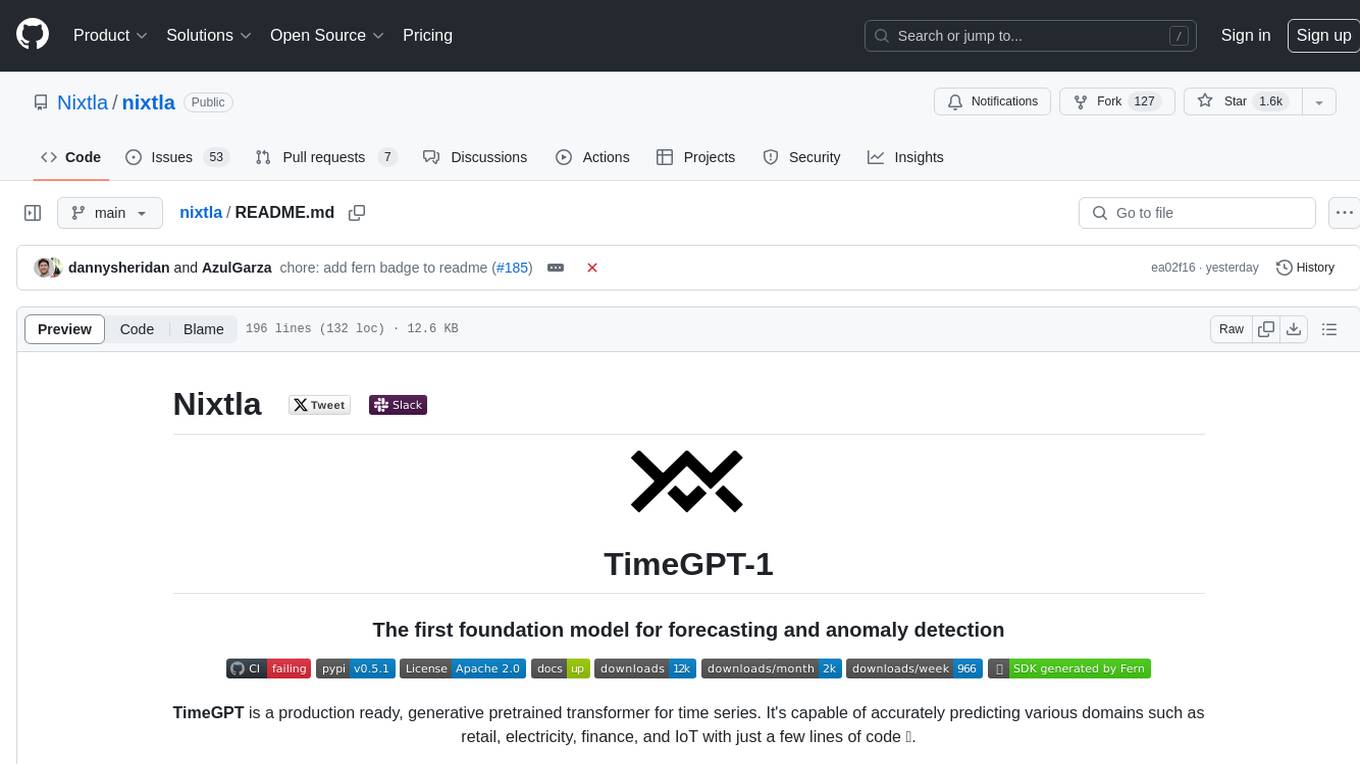
nixtla
Nixtla is a production-ready generative pretrained transformer for time series forecasting and anomaly detection. It can accurately predict various domains such as retail, electricity, finance, and IoT with just a few lines of code. TimeGPT introduces a paradigm shift with its standout performance, efficiency, and simplicity, making it accessible even to users with minimal coding experience. The model is based on self-attention and is independently trained on a vast time series dataset to minimize forecasting error. It offers features like zero-shot inference, fine-tuning, API access, adding exogenous variables, multiple series forecasting, custom loss function, cross-validation, prediction intervals, and handling irregular timestamps.
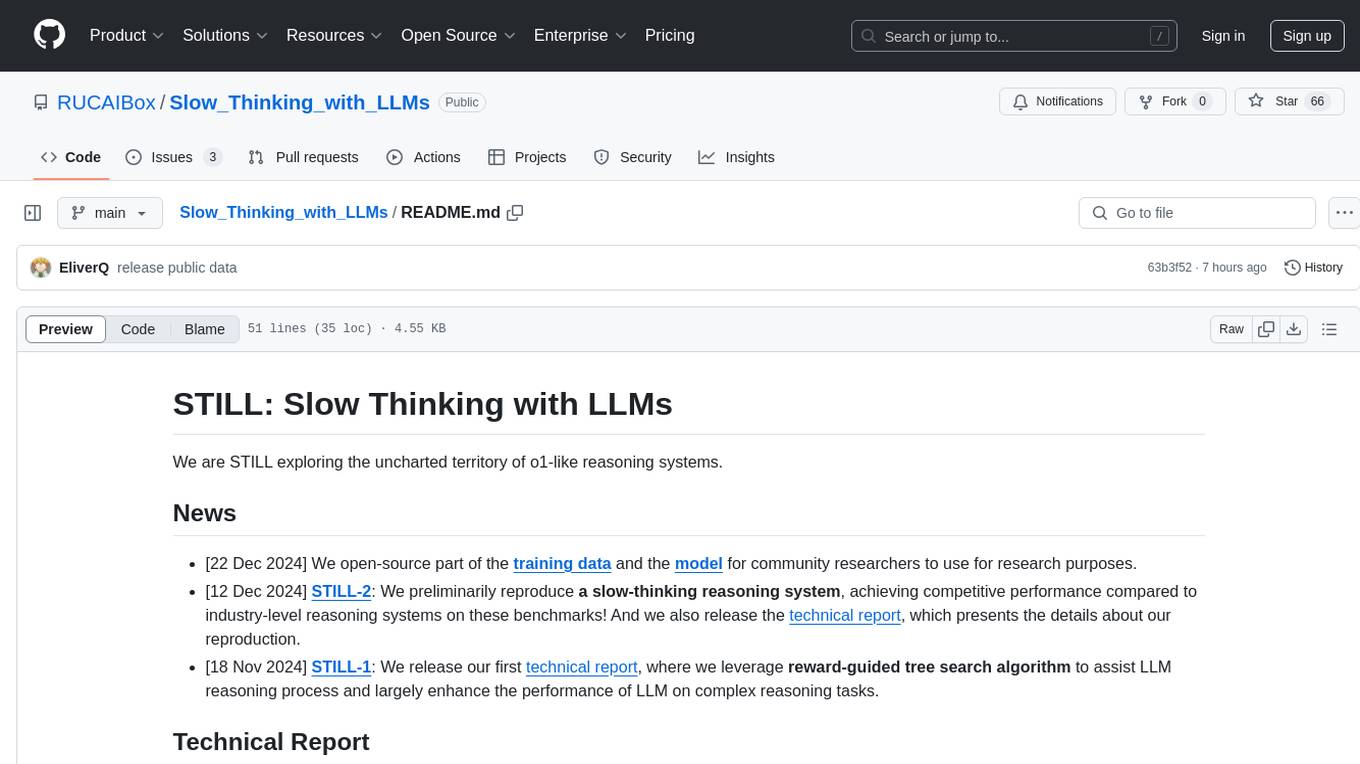
Slow_Thinking_with_LLMs
STILL is an open-source project exploring slow-thinking reasoning systems, focusing on o1-like reasoning systems. The project has released technical reports on enhancing LLM reasoning with reward-guided tree search algorithms and implementing slow-thinking reasoning systems using an imitate, explore, and self-improve framework. The project aims to replicate the capabilities of industry-level reasoning systems by fine-tuning reasoning models with long-form thought data and iteratively refining training datasets.
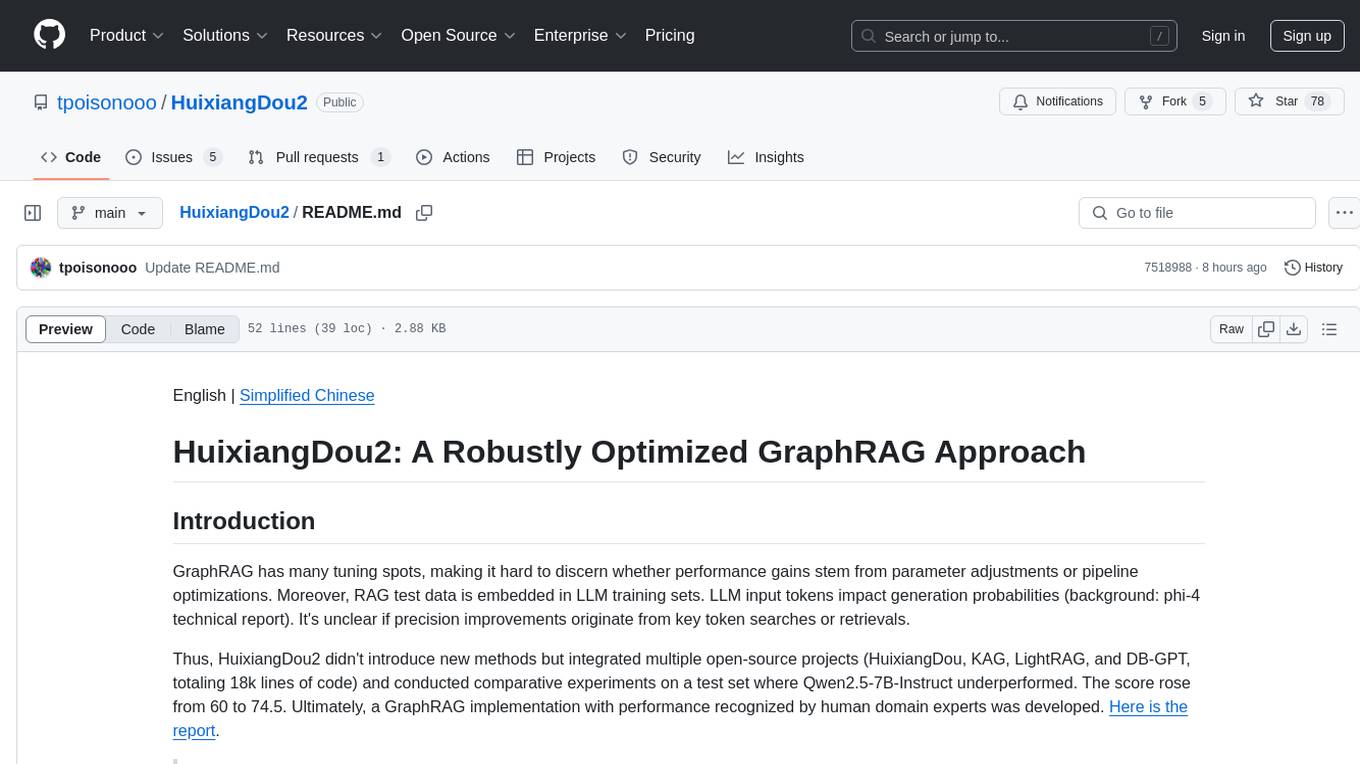
HuixiangDou2
HuixiangDou2 is a robustly optimized GraphRAG approach that integrates multiple open-source projects to improve performance in graph-based augmented generation. It conducts comparative experiments and achieves a significant score increase, leading to a GraphRAG implementation with recognized performance. The repository provides code improvements, dense retrieval for querying entities and relationships, real domain knowledge testing, and impact analysis on accuracy.
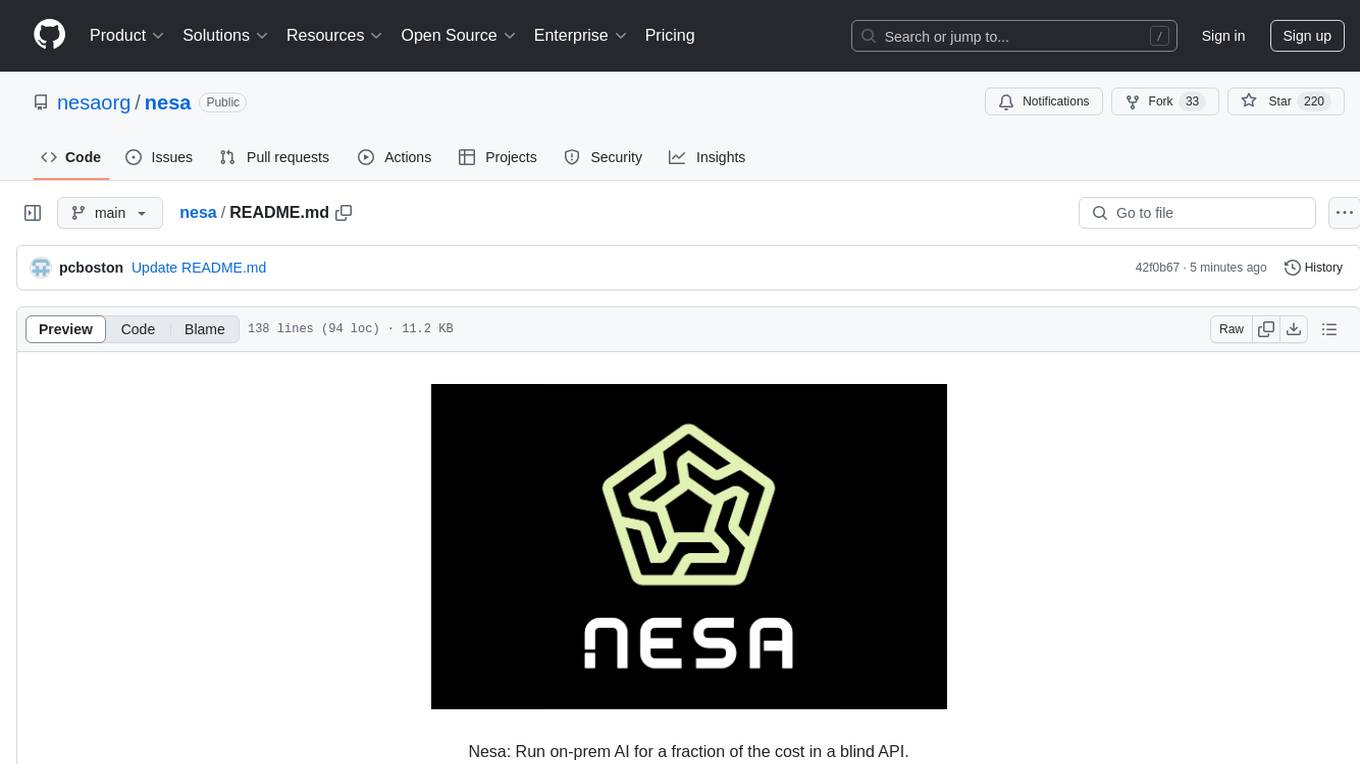
Equivariant-Encryption-for-AI
At Nesa, privacy is a critical objective. Equivariant Encryption (EE) is a solution developed to perform inference on neural networks without exposing input and output data. EE integrates specialized transformations for neural networks, maintaining data privacy while ensuring inference operates correctly on encrypted inputs. It provides the same latency as plaintext inference with no slowdowns and offers strong security guarantees. EE avoids the computational costs of traditional Homomorphic Encryption (HE) by preserving non-linear neural functions. The tool is designed for modern neural architectures, ensuring accuracy, scalability, and compatibility with existing pipelines.
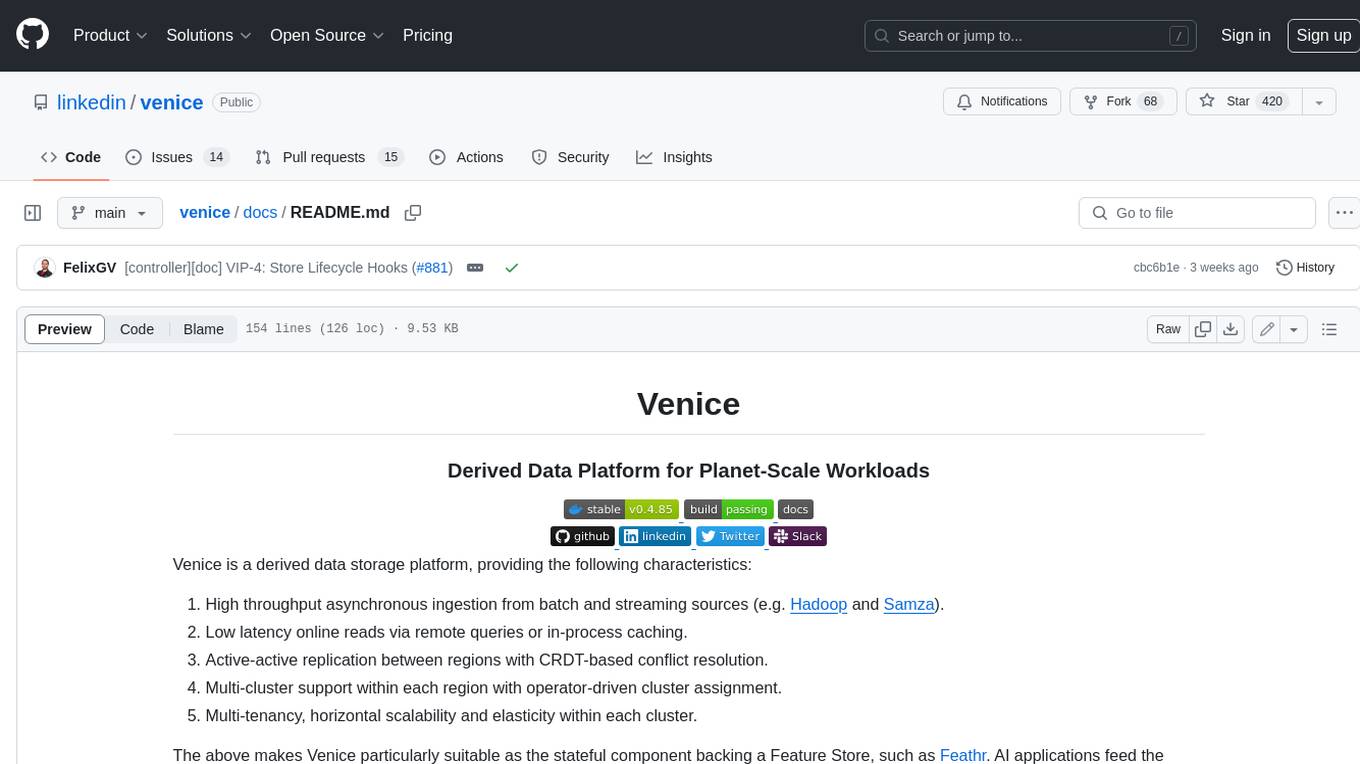
venice
Venice is a derived data storage platform, providing the following characteristics: 1. High throughput asynchronous ingestion from batch and streaming sources (e.g. Hadoop and Samza). 2. Low latency online reads via remote queries or in-process caching. 3. Active-active replication between regions with CRDT-based conflict resolution. 4. Multi-cluster support within each region with operator-driven cluster assignment. 5. Multi-tenancy, horizontal scalability and elasticity within each cluster. The above makes Venice particularly suitable as the stateful component backing a Feature Store, such as Feathr. AI applications feed the output of their ML training jobs into Venice and then query the data for use during online inference workloads.
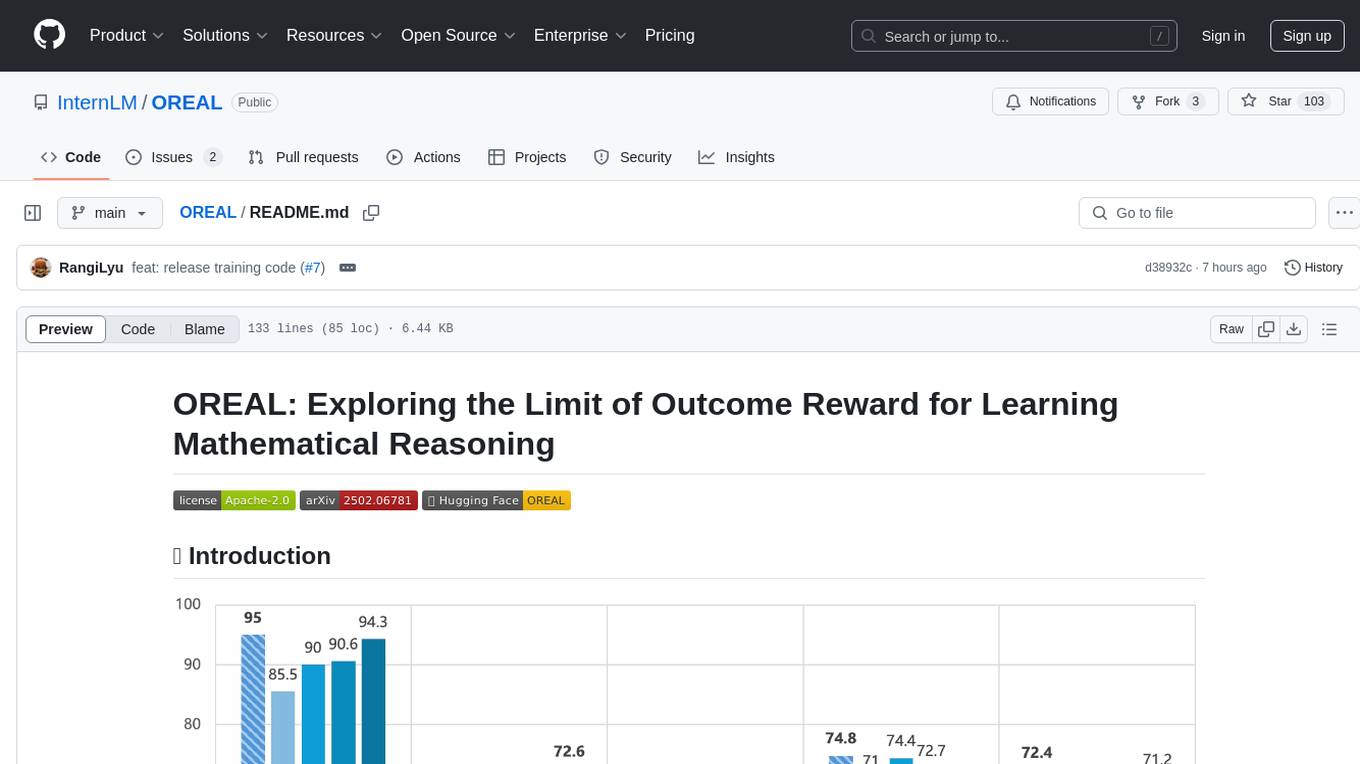
OREAL
OREAL is a reinforcement learning framework designed for mathematical reasoning tasks, aiming to achieve optimal performance through outcome reward-based learning. The framework utilizes behavior cloning, reshaping rewards, and token-level reward models to address challenges in sparse rewards and partial correctness. OREAL has achieved significant results, with a 7B model reaching 94.0 pass@1 accuracy on MATH-500 and surpassing previous 32B models. The tool provides training tutorials and Hugging Face model repositories for easy access and implementation.
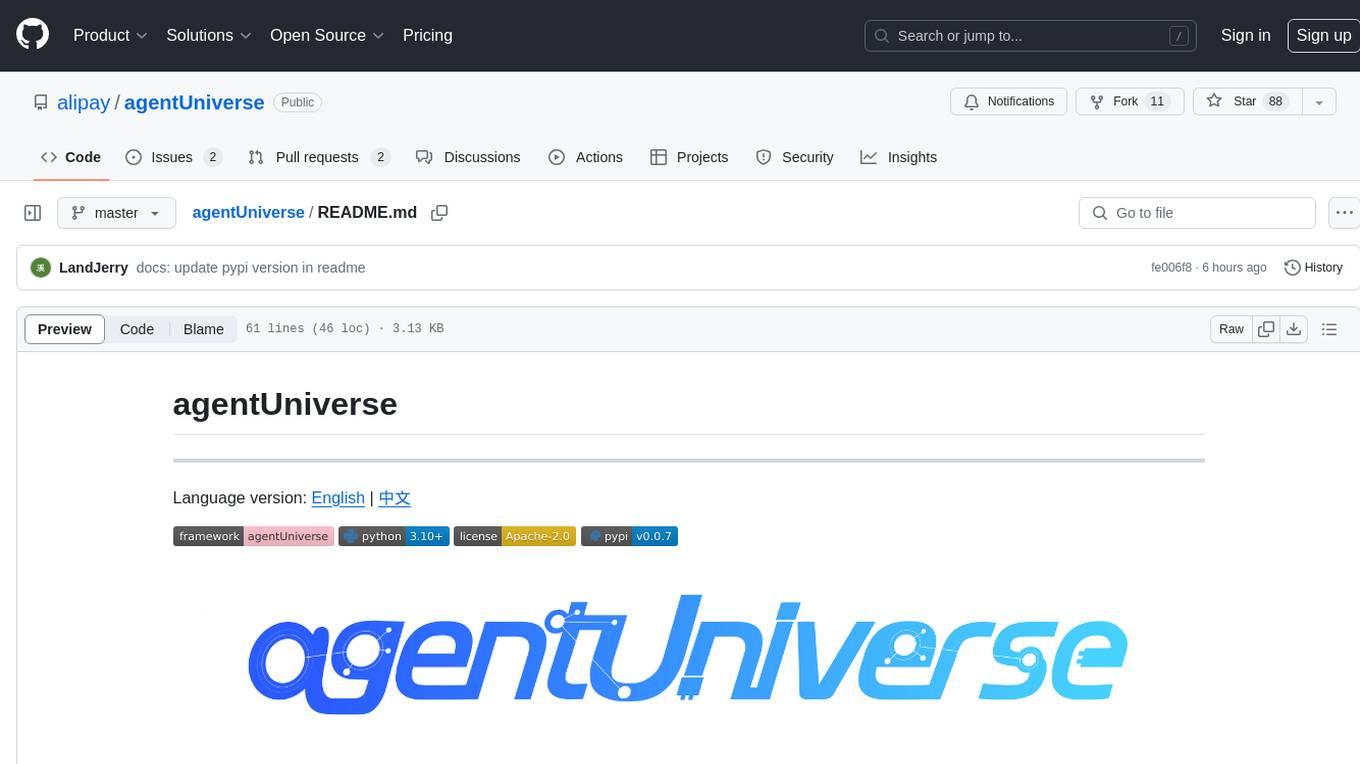
agentUniverse
agentUniverse is a framework for developing applications powered by multi-agent based on large language model. It provides essential components for building single agent and multi-agent collaboration mechanism for customizing collaboration patterns. Developers can easily construct multi-agent applications and share pattern practices from different fields. The framework includes pre-installed collaboration patterns like PEER and DOE for complex task breakdown and data-intensive tasks.
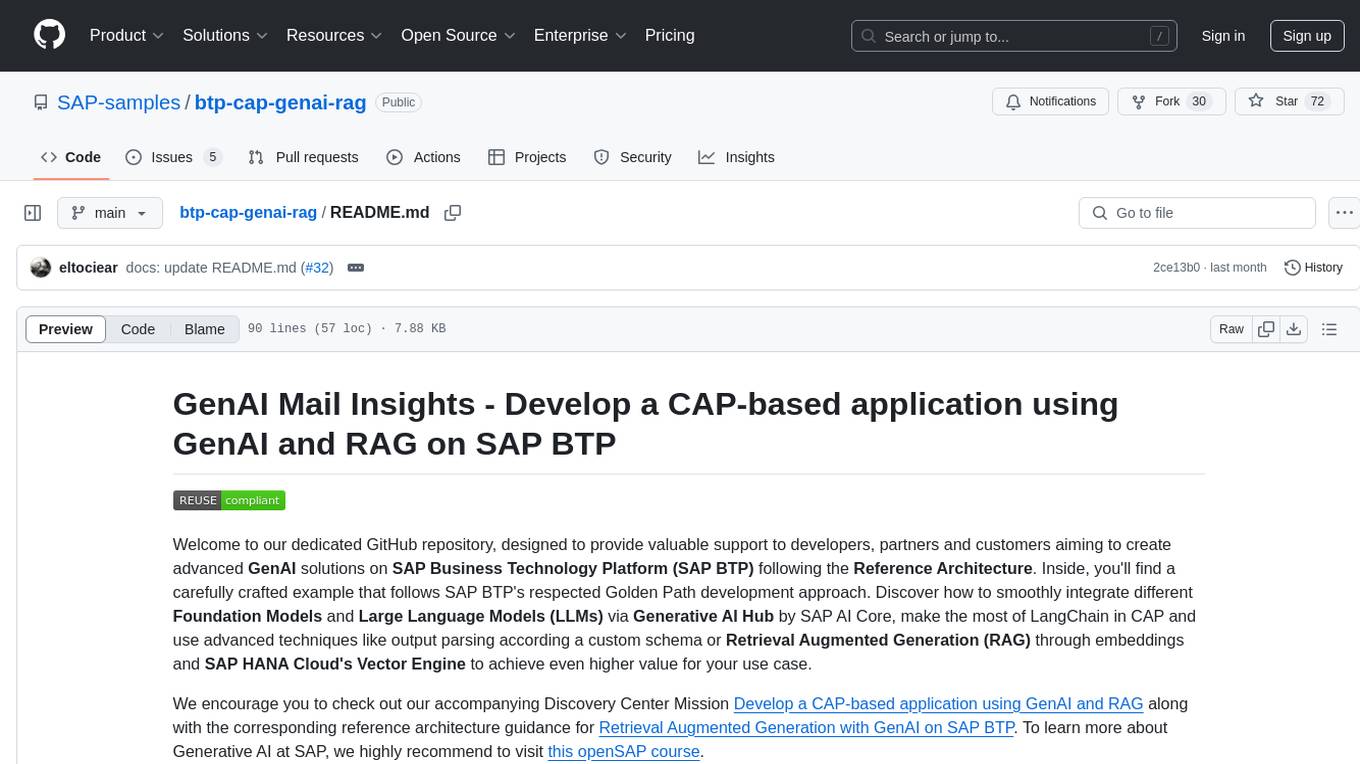
btp-cap-genai-rag
This GitHub repository provides support for developers, partners, and customers to create advanced GenAI solutions on SAP Business Technology Platform (SAP BTP) following the Reference Architecture. It includes examples on integrating Foundation Models and Large Language Models via Generative AI Hub, using LangChain in CAP, and implementing advanced techniques like Retrieval Augmented Generation (RAG) through embeddings and SAP HANA Cloud's Vector Engine for enhanced value in customer support scenarios.
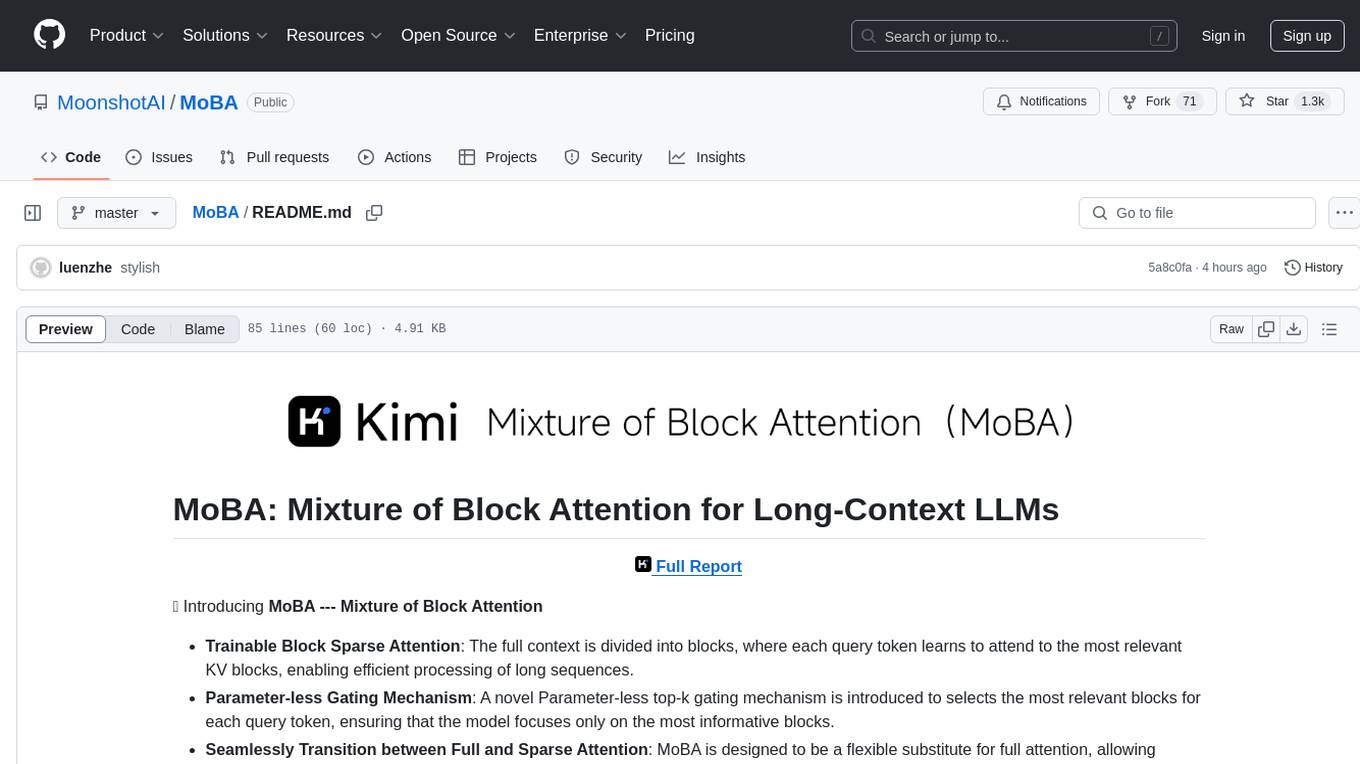
MoBA
MoBA (Mixture of Block Attention) is an innovative approach for long-context language models, enabling efficient processing of long sequences by dividing the full context into blocks and introducing a parameter-less gating mechanism. It allows seamless transitions between full and sparse attention modes, enhancing efficiency without compromising performance. MoBA has been deployed to support long-context requests and demonstrates significant advancements in efficient attention computation for large language models.
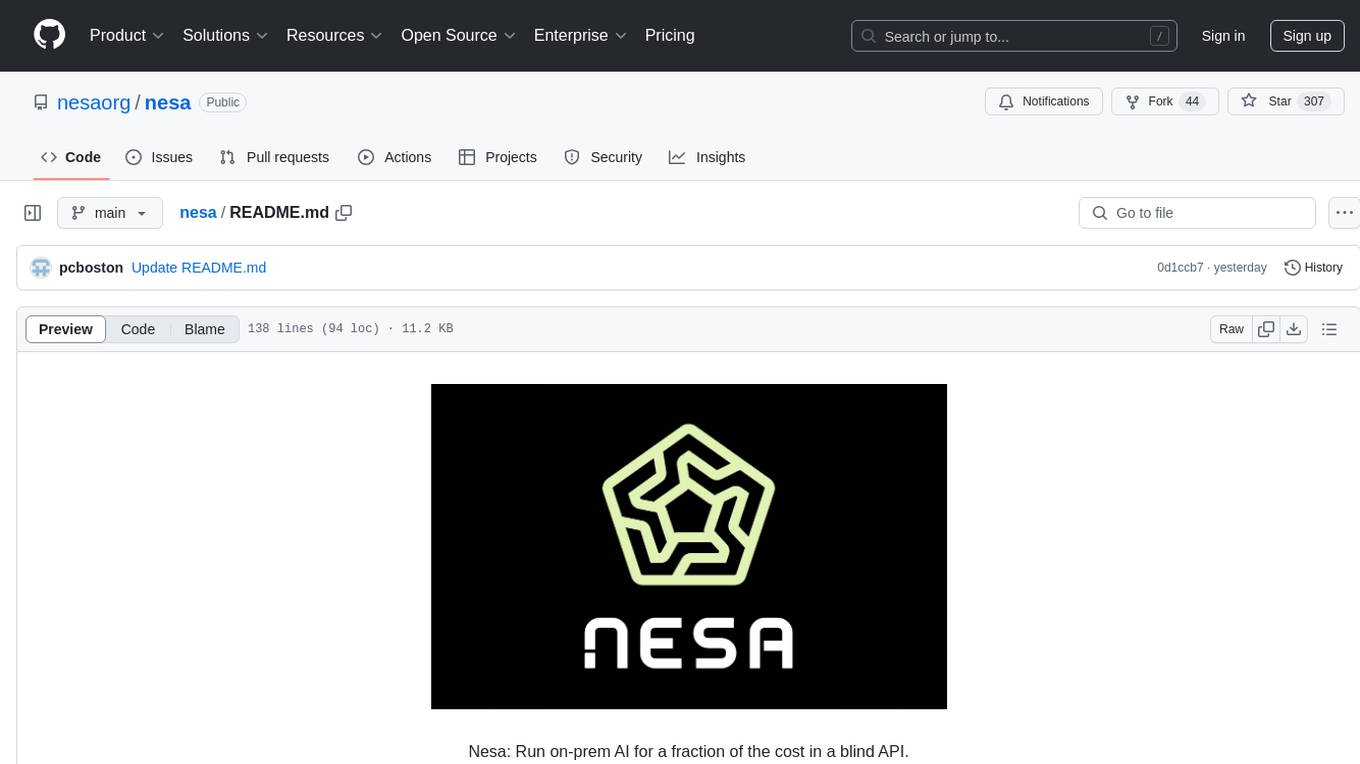
nesa
Nesa is a tool that allows users to run on-prem AI for a fraction of the cost through a blind API. It provides blind privacy, zero latency on protected inference, wide model coverage, cost savings compared to cloud and on-prem AI, RAG support, and ChatGPT compatibility. Nesa achieves blind AI through Equivariant Encryption (EE), a new security technology that provides complete inference encryption with no additional latency. EE allows users to perform inference on neural networks without exposing the underlying data, preserving data privacy and security.
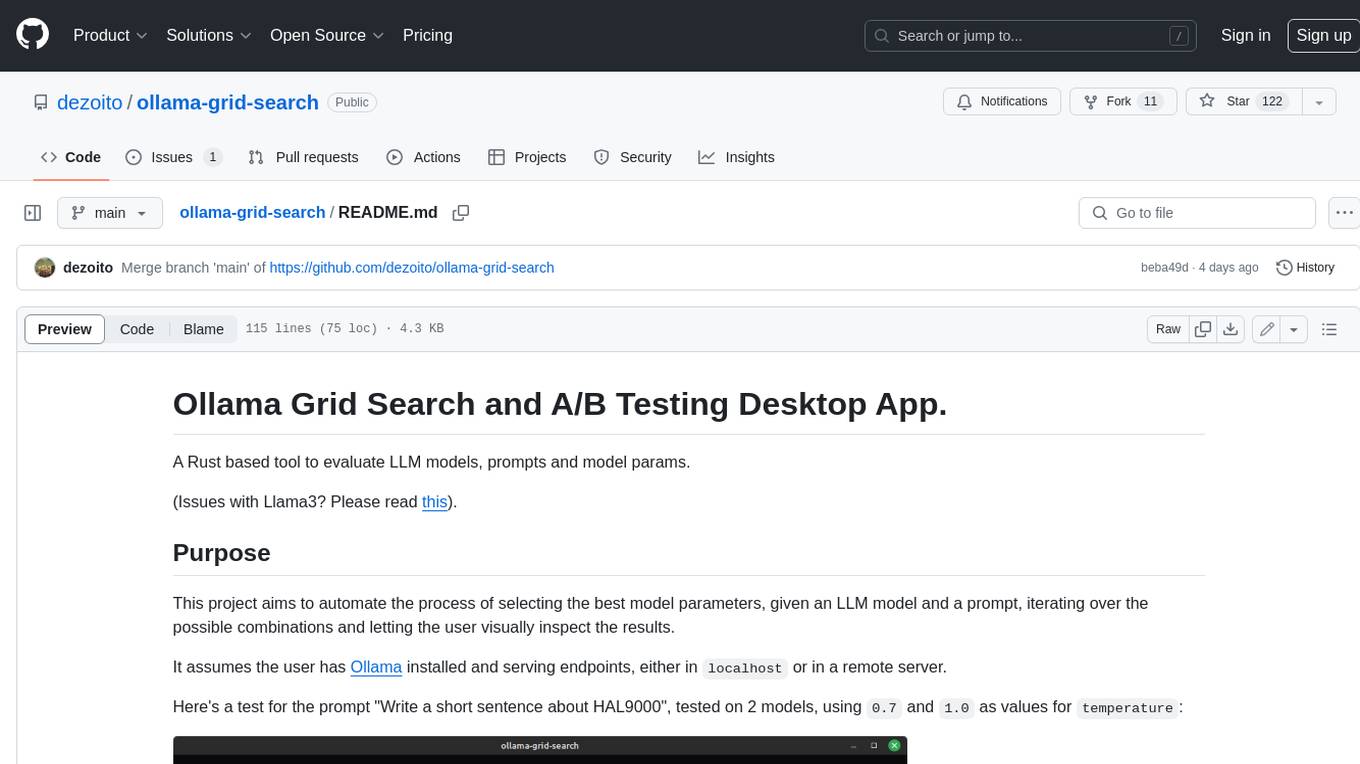
ollama-grid-search
A Rust based tool to evaluate LLM models, prompts and model params. It automates the process of selecting the best model parameters, given an LLM model and a prompt, iterating over the possible combinations and letting the user visually inspect the results. The tool assumes the user has Ollama installed and serving endpoints, either in `localhost` or in a remote server. Key features include: * Automatically fetches models from local or remote Ollama servers * Iterates over different models and params to generate inferences * A/B test prompts on different models simultaneously * Allows multiple iterations for each combination of parameters * Makes synchronous inference calls to avoid spamming servers * Optionally outputs inference parameters and response metadata (inference time, tokens and tokens/s) * Refetching of individual inference calls * Model selection can be filtered by name * List experiments which can be downloaded in JSON format * Configurable inference timeout * Custom default parameters and system prompts can be defined in settings
For similar tasks

llm-course
The LLM course is divided into three parts: 1. 🧩 **LLM Fundamentals** covers essential knowledge about mathematics, Python, and neural networks. 2. 🧑🔬 **The LLM Scientist** focuses on building the best possible LLMs using the latest techniques. 3. 👷 **The LLM Engineer** focuses on creating LLM-based applications and deploying them. For an interactive version of this course, I created two **LLM assistants** that will answer questions and test your knowledge in a personalized way: * 🤗 **HuggingChat Assistant**: Free version using Mixtral-8x7B. * 🤖 **ChatGPT Assistant**: Requires a premium account. ## 📝 Notebooks A list of notebooks and articles related to large language models. ### Tools | Notebook | Description | Notebook | |----------|-------------|----------| | 🧐 LLM AutoEval | Automatically evaluate your LLMs using RunPod |  | | 🥱 LazyMergekit | Easily merge models using MergeKit in one click. |  | | 🦎 LazyAxolotl | Fine-tune models in the cloud using Axolotl in one click. |  | | ⚡ AutoQuant | Quantize LLMs in GGUF, GPTQ, EXL2, AWQ, and HQQ formats in one click. |  | | 🌳 Model Family Tree | Visualize the family tree of merged models. |  | | 🚀 ZeroSpace | Automatically create a Gradio chat interface using a free ZeroGPU. |  |
For similar jobs

weave
Weave is a toolkit for developing Generative AI applications, built by Weights & Biases. With Weave, you can log and debug language model inputs, outputs, and traces; build rigorous, apples-to-apples evaluations for language model use cases; and organize all the information generated across the LLM workflow, from experimentation to evaluations to production. Weave aims to bring rigor, best-practices, and composability to the inherently experimental process of developing Generative AI software, without introducing cognitive overhead.

agentcloud
AgentCloud is an open-source platform that enables companies to build and deploy private LLM chat apps, empowering teams to securely interact with their data. It comprises three main components: Agent Backend, Webapp, and Vector Proxy. To run this project locally, clone the repository, install Docker, and start the services. The project is licensed under the GNU Affero General Public License, version 3 only. Contributions and feedback are welcome from the community.

oss-fuzz-gen
This framework generates fuzz targets for real-world `C`/`C++` projects with various Large Language Models (LLM) and benchmarks them via the `OSS-Fuzz` platform. It manages to successfully leverage LLMs to generate valid fuzz targets (which generate non-zero coverage increase) for 160 C/C++ projects. The maximum line coverage increase is 29% from the existing human-written targets.

LLMStack
LLMStack is a no-code platform for building generative AI agents, workflows, and chatbots. It allows users to connect their own data, internal tools, and GPT-powered models without any coding experience. LLMStack can be deployed to the cloud or on-premise and can be accessed via HTTP API or triggered from Slack or Discord.

VisionCraft
The VisionCraft API is a free API for using over 100 different AI models. From images to sound.

kaito
Kaito is an operator that automates the AI/ML inference model deployment in a Kubernetes cluster. It manages large model files using container images, avoids tuning deployment parameters to fit GPU hardware by providing preset configurations, auto-provisions GPU nodes based on model requirements, and hosts large model images in the public Microsoft Container Registry (MCR) if the license allows. Using Kaito, the workflow of onboarding large AI inference models in Kubernetes is largely simplified.

PyRIT
PyRIT is an open access automation framework designed to empower security professionals and ML engineers to red team foundation models and their applications. It automates AI Red Teaming tasks to allow operators to focus on more complicated and time-consuming tasks and can also identify security harms such as misuse (e.g., malware generation, jailbreaking), and privacy harms (e.g., identity theft). The goal is to allow researchers to have a baseline of how well their model and entire inference pipeline is doing against different harm categories and to be able to compare that baseline to future iterations of their model. This allows them to have empirical data on how well their model is doing today, and detect any degradation of performance based on future improvements.

Azure-Analytics-and-AI-Engagement
The Azure-Analytics-and-AI-Engagement repository provides packaged Industry Scenario DREAM Demos with ARM templates (Containing a demo web application, Power BI reports, Synapse resources, AML Notebooks etc.) that can be deployed in a customer’s subscription using the CAPE tool within a matter of few hours. Partners can also deploy DREAM Demos in their own subscriptions using DPoC.



